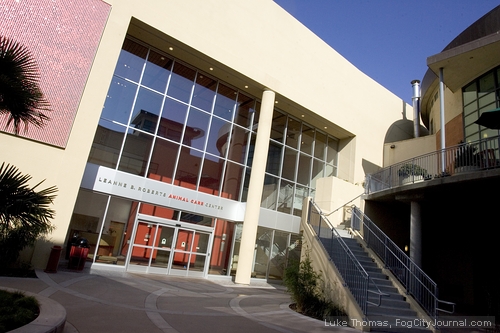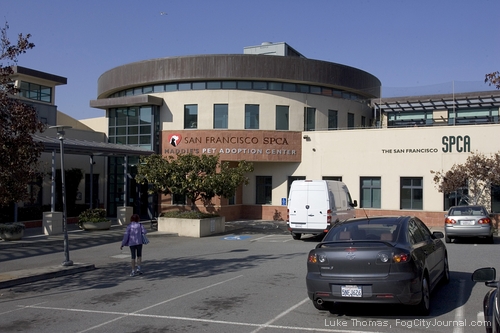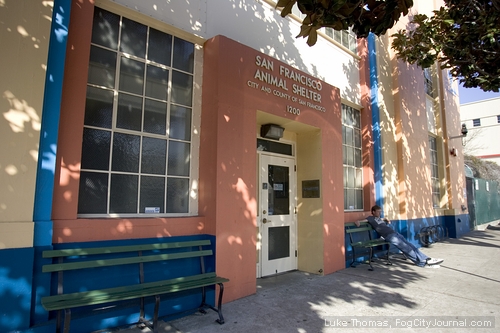
Animal welfare groups allege the San Francisco Society for the Prevention of Cruelty to Animals
has implemented new cost-cutting policies, detrimental to animal welfare,
as a result of cost overruns for its new $30 million Leanne B. Roberts Animal Care Center (above).
Photos by Luke Thomas
By Hope Johnson
February 3, 2009
Animal welfare watchdog groups held a demonstration Saturday during an open house for the new Leanne B. Roberts Animal Care Center to protest cost cutting measures and policy changes being implemented by the San Francisco Society for the Prevention of Cruelty to Animals (SFSPCA).
FixSanFrancisco.org and Change SF/SPCA allege the SFSPCA is shifting away from its “no kill” policy to help close an $8 million dollar construction shortfall on its new $30 million hospital.
“We are hoping this protest will raise the awareness in the public about SPCA’s opposition of the no kill initiative,” said Kin Tso of Change SF/SPCA. “We are asking members of the public to write letters to Catherine Brown of the Board of Directors, encouraging the board to reinstate the no-kill initiative into the mission statement and recapture the proud history of the SFSPCA.”
The term “no-kill” is commonly defined as saving all healthy and treatable animals, reserving euthanasia only for unhealthy and untreatable animals. Controversy arises as organizations attempt to agree on the definitions of “healthy” and “treatable.”
FixSanFrancisco.org was formed by former SFSPCA volunteers in response to changes being instituted by SFSPCA President Jan McHugh-Smith. Community programs and programs aimed at saving the lives of cats and dogs considered hard to adopt, have been systematically eliminated or severely reduced. FixSanFrancisco.org has become a voice for many rescue group workers reluctant to publicly criticize the SFSPCA’s changes for fear of disadvantaging the animals their group’s help.
In April last year, the SFSPCA abruptly closed its popular 30-year-old Hearing Dog Program, which matched specially trained dogs with hearing-impaired clients. Employees of the program were told the program cost $400,000 more than it raised in contributions. Likewise, the Cat Behavior Program, which used behavior modification techniques to help excessively shy or play-aggressive cats develop adoptable behaviors, was also reduced. As a result, fewer “behavior” cats are now accepted by the SFSPCA, boosting adoption statistics, but saving fewer lives.
Around the same time, the second floor of SFSPCA Maddie’s Adoption Center was closed. According to one SFSPCA docent, “[The SFSPCA] just consolidated. It was too overwhelming for people to have so many cats to choose from.” However, this also eliminates the cost of housing cats previously offered a chance at adoption.
Shortly after the closure at Maddie’s, SFSPCA changed its policy on testing kittens for feline leukemia. Previously, kittens testing positive for leukemia were housed for up to three months and retested to ensure against false-positive results. Under the SFSPCA’s new cost-cutting policies, kittens are tested only once while under anesthesia for spay/neuter procedures, and euthanized immediately if the test is positive.
“We are here today because we want the San Francisco SPCA to adhere to no kill protocols,” said Marc Toft of FixSanFrancisco.org. “One of the biggest ones is that we want San Francisco to expand its definition of adoptable animals.”
Some are left wondering if the changes will force Animal Care and Control (ACC), the City’s animal shelter, and other less well-funded rescue groups, to bear the burden of keeping up San Francisco’s 87 percent live-release rate, while the wealthier SFSPCA takes only the easiest animals to adopt while enjoying the publicity of a “no-kill” shelter.
“Prior to Jan [McHugh-Smith] coming on board, SFSPCA used to take a lot of behavior cats and they’re not doing that anymore,” said Lana Bajsel of Give Me Shelter, a cat rescue group assisting ACC. “I get called on every behavior cat from [ACC]. The SFSPCA should be taking those, and they’re not.”
The SFSPCA acted as San Francisco’s animal control agency from 1905 until 1989, when the society declared it would adopt a “no-kill” policy. In response, the City of San Francisco opened the ACC to handle difficult behavior and euthanasia cases the SFSPCA refuses to accept.
The SFSPCA enjoys a 60,000 square foot, $30 million “animal care center,” a $14 million annual budget, 12 veterinarians, but only treats cats and dogs. By comparison, ACC has a $3.8 million annual budget, accepts all types of animals from the public, employs one veterinarian and one assistant, and is facing a 25 percent budget cut this year due to the City’s $576 million budget shortfall.

San Francisco SPCA.

San Francisco Animal Care and Control.
Due to financial concerns in the economy, Give Me Shelter is unable to help ACC adopt cats for the next three months. “It’s heartbreak for us because we are the largest cat rescue group pulling from ACC,” said Lana Bajsel. “We are concerned those animals are going to perish because the SFSPCA is declining behavior cats.”
The full impact of policy changes at the SFSPCA is still unknown. Neither the ACC or SFSPCA have yet released statistical information covering the past six months. Several groups have begun a dialogue with the SFSPCA facilitated through the Animal Welfare Commission, the city agency overseeing animal issues within San Francisco.
The SFSPCA did not return calls for comment at the time of publishing.
Update, 2/4/09: “In no way has the SPCA changed policy regarding no-kill. We continue to guarantee a home for every healthy dog and cat and also provide treatment for thousands of animals every year,” said SFSPCA Vice-President Dori Villalon.
Villalon said the Hearing Dog program was eliminated to focus on the SFSPCA’s “core mission” of saving the lives of homeless cats and dogs, and there are other rescue groups focusing on service dogs. She said the second floor of the adoption center is closed to the public but continues to house cats.
The SFSPCA does set behavior standards for cats it will accept from ACC but has also begun to take cats with various medical conditions it could not previously accept. Villalon said some animals don’t do well in shelter environments and expressed gratitude for rescue groups that step in on behalf of animals the SFSPCA is unable to accept.

 The Hunger Site
The Hunger Site
February 12, 2009 at 9:25 pm
It is absolutely true that Jan McHugh Smith opening said that the term ‘No-Kill’ is misleading at the Animal Welfare Commission meeting in January 8th. The SFSPCA is responding to negative publicity since the closure of the Hearing Dog Program, the SF Weekly article, the online petition and the protest last month, and try to regain their ability to solicit donations by supporting No-Kill nation. Here is the link to their latest PR manoeuvre http://www.sfspca.org/about-us/presidents-message/no-kill-nation.html. It should also be noted Richard Avanzino (the pioneer of the No-Kill movement) was quoted in Nathan Winograd’s book Redemption (pg 149) saying “The Asilomer Accords were a compromise to get buy-in. We had to make concessions in order to get transparency of statistics. It is a flawed document, imperfect. It isn’t what we wanted in total…..” To use the Asilomer Accords as the bible for the No-Kill movement, is like to substitute Cliff Notes version of Shakespear to the real thing.
February 3, 2009 at 4:40 pm
When you hand pick the most easily adoptable animals from out of county shelters, as does the SPCA, you are not only condemning some S.F, animals to grim prospects for a future, but are condemning the less easily adoptable animals at those out of county shelters to likely death. Shelters that are not as rich as the SFSPCA need their more difficult animals – those with health or behavior concerns that they do not have the resources to support – to be embraced by the SFSPCA, not the other way around. You do not have to be the one depressing the plunger and administering the sedative overdose to none the less contribute to an innocent animal’s death. San Francisco animals come first. San Francisco has an impressive live release rate, for sure, but San Francisco can do better. The SFSPCA is suddently publishing statements regarding their commitment to a No Kill Nation, yet just a month ago at an Animal Welfare Commission meeting, the President clearly stated that they resist the term “no kill”. Please do some research. Read between the lines. Visit FixSanFrancisco.org.
February 3, 2009 at 2:11 pm
The SFSPCA has 12 freaking veterinarians $14 million annually and turns away animals they consider unadoptable? That is not a rescue shelter that is a high end consignment boutique for gently used pets.
I’d cut the ACC some slack here.